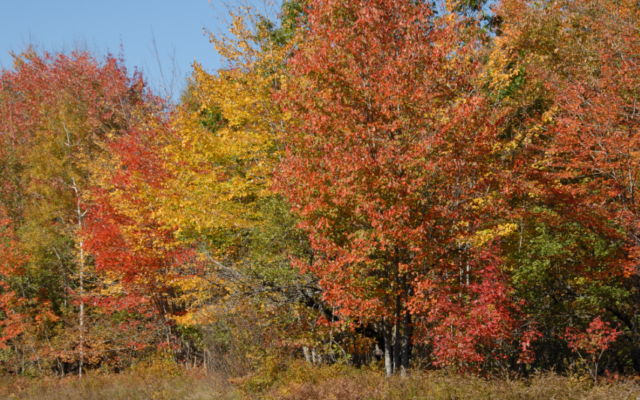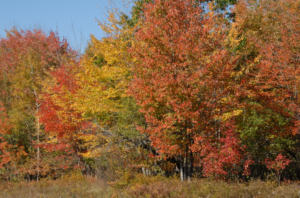
How to better plan your fall foliage outings in Maine
A dazzling time of year, fall foliage season marks the end of summer with a fiery display that transforms the Maine landscape. The spectacular show lasts just a few weeks. If you drag your feet, you just might miss it.
To truly embrace the season, many people plan special outings to find the most vibrant colors. Whether you’re visiting Maine for the first time or you’ve lived here for many years, leaf peeping is a fun activity that brings joy to all ages. To help you get the most out of the experience, here are a few tips.
Time it right
To learn when leaves are changing color in different parts of the state, check out the Maine Fall Foliage Report, which is issued weekly by the Maine Department of Agriculture, Conservation and Forestry. The report tracks the color progress across the state using a network of observers, including Maine forest rangers and forest pathologists.
The report is updated on Wednesday afternoons, typically starting mid-September and running through October, until most of the leaves have fallen from the trees or faded to brown. To view the full reports, including color-coded maps that divide the state up into different zones, visit mainefoliage.com. You can also sign up for the weekly report to be sent to you via email on the website.

Bangor Daily News file photo
SEASONAL FOLIAGE — Autumn colors approach their peak amidst the hardwoods growing alongside Route 15 in Guilford.
Extend the season
Maine is a big state that varies in temperature from south to north, and from the coast to inland areas. This matters when it comes to fall foliage because temperature is one of the main factors for when leaves change color. Generally, leaves change color in colder regions first. Therefore, in Maine, fall foliage progresses from north to south. Leaves also tend to change color in inland mountainous regions before they do along the coast.
With this in mind, you can sometimes enjoy peak fall foliage for a few weeks by planning trips to different regions of Maine. For example, in mid-September, the leaves might be mostly green in southern Maine, but in Aroostook County, color could be popping up all over the landscape.
Spot color early
One trick for spotting colorful trees early in the season is visiting areas where trees are facing less than ideal growing conditions. When stressed, trees sometimes tap out early in the season and stop producing green chlorophyll. As this natural pigment breaks down, the leaves’ fall colors are revealed.
A prime example of this is when trees along roadways turn color before trees that are deeper in the forest. Roadside trees are sometimes stressed by road salt, dust and lack of water. Another example is when trees change color early in regions experiencing drought.
In addition, some of the trees that grow around wetlands, such as silver and red maple, tend to change color earlier. So if you’re in an area that is still largely green, seek out a road or trail that travels by a bog.
Seek out certain trees
When it comes to fall color, certain tree species outshine the rest. In Maine, some of our most colorful trees are sugar maples and red maples. Their leaves often bleed into bright orange, blood red and even peach and purple. Less common black gum trees are also known to be among the showiest fall trees, with their leaves turning bright red and sometimes orange.
Oak trees also put on a show, with leaves transitioning to orange and gold late in the season. Birch trees often display yellows, as do aspen trees. And beech leaves tend to turn a rusty orange and cling to branches well into the winter.
Some understory plants can also turn bright colors. Hobblebush, for example, is a broad-leafed shrub found in shady, wet woods throughout Maine, and its leaves often turn bright reddish purple. And blueberry plants are known for turning bright red. Visit one of Maine’s many blueberry fields and see for yourself. Blueberries also grow atop many of the state’s mountains, including mountains in Acadia National Park.
In general, seek out areas with plenty of deciduous trees rather than conifer forests. The only Maine conifer that changes color in the fall is the tamarack, which has soft needles that turn golden and fall off, just like leaves, to grow back again the following spring.
Plan for chilly weather
Fall in Maine is a time for flannels, fleece and at times, wool hats. Though summer was only yesterday, the temperature drops quickly during this time of year, especially in the evening. While enjoying the beautiful fall foliage, stay cozy by packing plenty of warm clothing layers. A thermos of hot cider can also significantly improve your leaf peeping experience.
Leave the road behind
Viewing the fall colors from the comfort of a car can be a lot of fun, but stepping out into the cool autumn air can really add to the experience. The rich scent of decaying leaves, while it doesn’t sound particularly appealing, is actually quite nice.
One way to spend time outside while leaf peeping is to select a well-marked and maintained trail. Do a little research ahead of time to select a trail that fits your needs, whether that’s a wheelchair-accessible path or a rugged hiking trail that leads to the top of a mountain. Some trails are known for being particularly good for viewing fall foliage. But whatever trail you choose in Maine, as long as it’s not in the thick of an evergreen forest, should lead you to plenty of colorful trees.
Another way to view fall foliage is by train. Maine is home to the Downeast Scenic Railroad and the Belfast and Moosehead Lake Railroad, both of which offer scenic day trips in open air coaches and have made changes to follow state and Centers for Disease Control and Prevention guidelines for safety during the COVID-19 pandemic.
Traveling by boat is another excellent way to view fall colors. There’s something especially beautiful about colorful trees reflecting in the water. Fall paddling can be more dangerous than summer paddling because the water is quickly becoming colder (which can cause paddlers to develop hypothermia faster if they fall in). It’s especially important to wear a life jacket and stick to paddling trips within your skill level. Or you could seek out a guided tour or boat cruise.
Look out for storms
Keep an eye on the weather forecast. If you see predictions for heavy rain or wind, you’ll want to get out there and enjoy the fall foliage beforehand. Wind and rain can bring a swift end to fall foliage season in Maine by knocking the already fragile leaves to the ground.